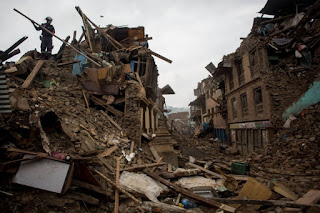 |
| The Human-Induced Earthquake Database (http://inducedearthquakes.org/) |
 |
| How human activity can trigger earthquakes (Science Magazine) |
So when fracking, and injection of fracking waste-fluid into the ground, was found to be causing earthquakes, I was not surprised.
Basically, even though we don't mean to, we can set off earthquakes by either (a) injecting pressurized fluid into the ground, or (b) moving a huge amount of mass around on the earth's surface, such as by impounding water in a reservoir or by removing rock from a large mine.
 |
"Some of the first data showing the relationship between wastewater injection and triggered seismicity was gathered at Rocky Mountain Arsenal near Denver, Colo., in the 1960s. Credit: K. Cantner, after Evans, The Mountain Geologist, v.3, 1966." (Earth Magazine)
|
Most of the time, when we do these things - inject fluid in the earth or shift huge masses around on its surface - it does not cause earthquakes. Even when we do set off inadvertent earthquakes, most of them are not noticeable to humans. They are too small for us to feel, even though we can detect them on seismograms.
 |
| Oklahoma house damaged by M5.7 EQ, 2011 (Brian Sherrod, Earth Magazine) |
But all those mosts leaves room for exceptions. Earthquakes big enough to be quite noticeable to humans, and big enough to cause damage, can be induced by human activities.
To show how common human-induced earthquakes are - or how rare, to look at it from another viewpoint? - take a look at The Human-Induced Earthquake Database. There are 728 earthquakes in the database, and the plan is to keep adding more as they occur and are reported.
While reading about the new database of human-triggered earthquakes, I was surprised to learn that it includes two really big earthquakes, with moment magnitudes of 7.8 and 7.9. The earthquakes in question are the M7.8 earthquake in Nepal in 2015 , more than 8,000 fatalities, and the M7.9 earthquake in Sichuan, China in 2008, more than 80,000 fatalities.
 |
| Nepal after M7.8 earthquake in 2015 (Nature Magazine) |
The Nepal earthquake has been associated with groundwater pumping and the Sichuan earthquake with the filling of a reservoir behind a dam. It is arguable whether they were human-triggered. The correlations between the types of human activity known to set off earthquakes, and these two earthquakes, may be coincidental. The two locations are in regions of frequent major earthquakes caused by the tectonic collision of India with the rest of Asia.
 |
| Sichuan, China, 2008 (Design & Survive) |
This parallels the debate about whether fracking has triggered earthquakes, given that the earthquakes occurred on pre-existing faults that were already under stress, and have previously had earthquakes, prior to any human influence. The earth has lots of faults. Many faults are on the verge of failure, and a nudge by humans may cause the fault to fail, which means: earthquake. That is why it is better to refer to such earthquakes as human-triggered rather than human-caused. For a human-induced earthquake, it takes two to tango - the earth ready to dance, the human activity getting it to shake loose and start to move.
 |
This bar graph, showing which types of human activities cause the most earthquakes, is an example of what you can do with the Induced Earthquake Database. (The Conversation, January 2017).
|
Comments
Post a Comment